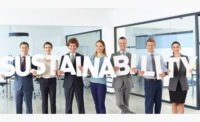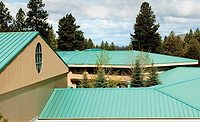Sustainable Roofing: How People Fit In






When we think about “sustainable” or “green,” we tend to focus on the environmental aspects of sustainability, including the key natural resources of energy, air, water and materials. But the best definitions of sustainability include two additional principles. First, true sustainability must make economic sense. That’s why sustainable rating programs like RoofPoint emphasize important economic features of roofing systems such as durability, installation quality and long-term maintenance. Second, beyond the obvious environmental and economic aspects of sustainability, all of these “green” things must be viewed in a human and social context. After all, the whole purpose of sustainable development is to make the world a better place for people — both the present and future generations.
Of course, we need to be good stewards of our natural resources to build sustainable roofs, and we need to make these roofs economically efficient over the long term. We also need to be sure the health and safety of both building occupants and roofing workers are assured. There are many ways we can contribute to “people sustainability” in roofing projects. Some examples of people-friendly roofing strategies that also make solid economic and environmental sense include:
- Reducing the potential for moisture infiltration and mold growth by installing roof vapor retarders and air barriers to minimize unwanted air and moisture movement. Also, consider implementing a comprehensive moisture-protection plan during installation to minimize the amount of moisture retained in the roof.
- Helping to provide consistent and uniform comfort in the building by using best insulation practices to reduce thermal “shorts” in the roofing system.
- Using roof areas as a social environment for building occupants. Examples include rooftop classrooms, environmental demonstration areas, exercise facilities and social meeting spaces.
- Installing permanent fall-protection systems and traffic-management plans to extend good safety practices beyond project installation and to help protect building-maintenance workers.
- Using low-VOC coatings, adhesives and sealants to reduce worker and occupant exposure to air-borne chemicals.
- Employing ergonomic tools and practices to increase productivity and reduce the potential for worker injury.
As market demand for sustainable roofing grows, these people-related strategies will become increasingly important. And as they grow in importance, there will be new opportunities for roofing contractors to sell added value. Greater “people-sustainability” awareness will make it easier to sell and install permanent fall protection systems to protect workers and maintenance crews. Demand for sustainable buildings will also grow demand for best roofing practices, including multiple staggered layers of roof insulation, air barriers, vapor retarders and many more. Finally, the increasing emphasis on sustainability will help raise the professionalism and image of our industry as a valuable contributor to the long-term success of the environment, our economy and all people who live and work under the roofs we install.
Looking for a reprint of this article?
From high-res PDFs to custom plaques, order your copy today!









